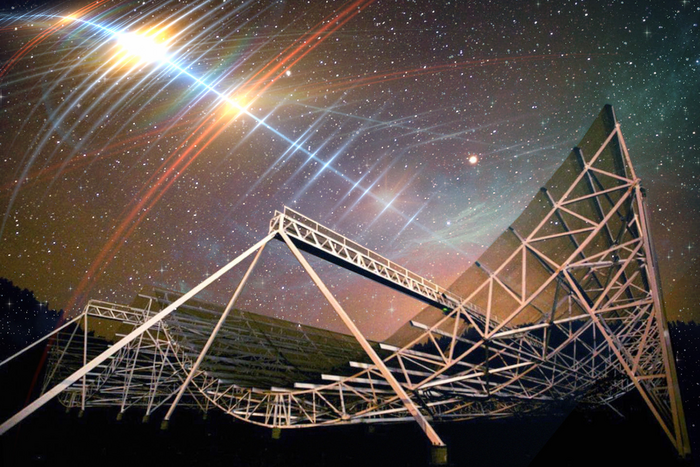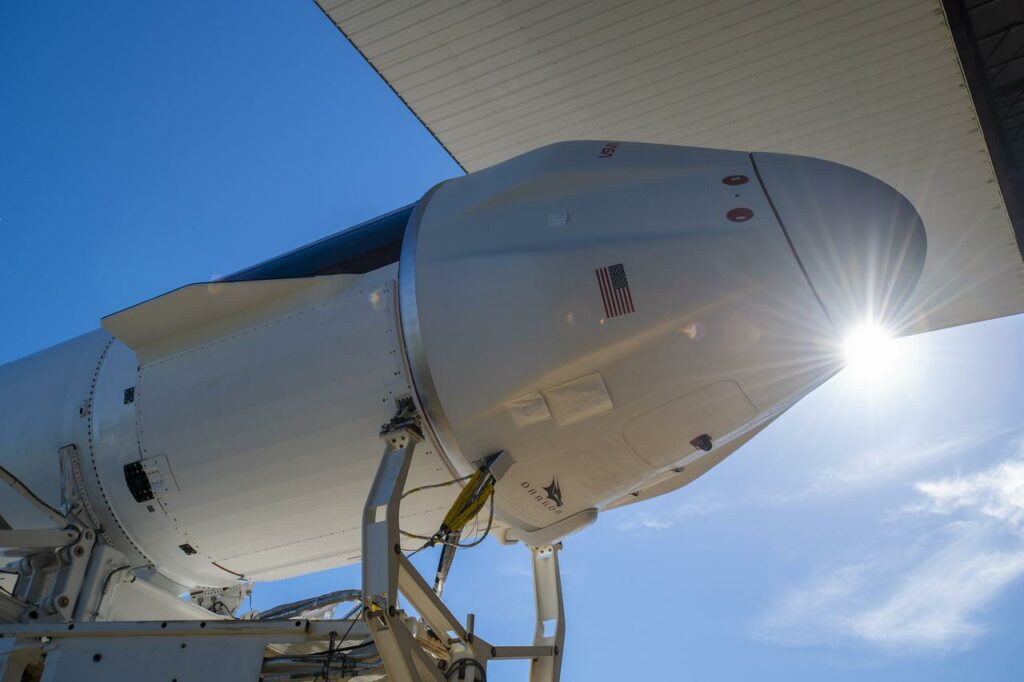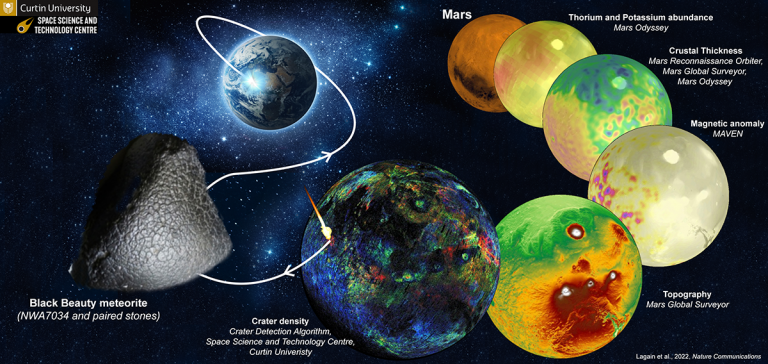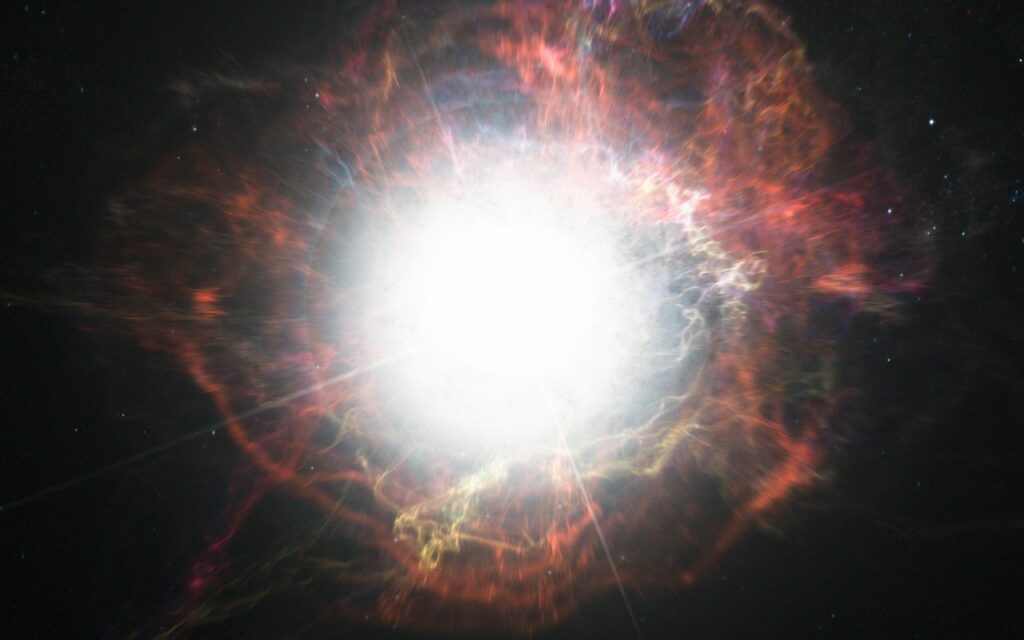Using layers of data from a variety of Martian missions, researchers have developed a machine learning algorithm that identified the actual crater from which a particular Martian meteorite originated. Plus, a radio heartbeat, and our last What’s Up and review of the season.
Podcast
Show Notes
It went “Boom Boom Boom” in the sky
- McGill press release
- MIT press release
- “Sub-second periodicity in a fast radio burst,” The CHIME/FRB Collabortion et al., 2022 July 13, Nature
CRS-25 will bring cargo to the ISS
- NASA press release
- Earth Surface Mineral Dust Source Investigation (NASA)
Machine learning pinpoints Martian meteorite origin
- Curtin University press release
- NAU press release
- “Early crustal processes revealed by the ejection site of the oldest martian meteorite,” A. Lagain et al., 2022 July 12, Nature Communications
Building artificial supernovae spectra with artificial intelligence
- RAS press release
What’s Up: Rest of Summer Preview
- Galilean Moons of Jupiter (The Shallow Sky)
- Summer meteors 2022: Moon-free in late July and early August (EarthSky)
Transcript
This is the last episode of our fifth season, and we’d like to give a mighty thank you to everyone out there watching who has supported us either for the last five years or five seconds.
Hi, new viewers! Welcome! We’ll be back with more new episodes in September.
During the summer, we’ll still be active on our main website, CosmoQuest.org, of which Daily Space is a part.
We’re going to be launching community science projects you can be part of, and as always, we have our Discord. So stay put. We have news, summer observing plans, and more right here on the Daily Space.
And we’ll have summer science options all summer long at CosmoQuest.org.
But for now, I am your host Dr. Pamela Gay.
I am your host Erik Madaus.
And we’re here to put science in your brain.

I’m just going to start this segment with a quote from researcher Daniele Michilli: It was unusual. Not only was it very long, lasting about three seconds, but there were periodic peaks that were remarkably precise, emitting every fraction of a second — boom, boom, boom — like a heartbeat.”
Michilli is describing the radio signal of a mysterious object that was spotted by the CHIME radio array as it watched the sky for fast radio bursts (FRBs).
First discovered in 2007, fast radio bursts are sudden and bright radio signals. Often, they last only fractions of a second and never repeat. This lack of predictability and repeatability for the vast majority of these signals has left many astronomers scratching their heads as we try and figure out just what is going on.
Or perhaps what variety of things is going on.
And this brings us to that “boom boom boom” of a signal that caught Michilli’s attention. Cataloged as FRB 20191221A, this signal lasted three seconds, and within those three seconds, its intensity varied with a 0.2-second beat.
This signal stood out both for its duration and for its beating. Fast radio bursts normally only last a fraction of a second as they crackle off a pulse, and while a few have been found that have periods of outbursts and periods of quiet that are predictable, this was the first time a longer pulse made of faster beats has been found. Adding to the mystery, the signal appears to originate in a galaxy several billion light years away, which implies this is an extraordinarily bright source.
An extraordinarily bright and super weird source that has outburst only once that we caught.
This object is discussed in a new paper in Nature that is presented by the CHIME Fast Radio Burst Collaboration. The paper suggests the source is some sort of a neutron star, like a pulsar, that for those three seconds was extraordinarily bright.
Last night on Facebook, I saw prominent astronomers doing the astronomer equivalent of “Hey, come look at this weird thing. Can’t quite tell what it is, but isn’t it cool?” Researchers around the world are now really hoping that patch of the sky goes “boom boom boom” again when our telescopes are looking. It may never happen. This may be a mystery for the ages; a mystery that, for three seconds, was the rhythm of the night.

One of the launches we’ve been expecting for a while now is CRS-25, SpaceX’s latest resupply mission to the International Space Station (ISS). CRS-25 was originally slated to launch on June 10 but was delayed first to July 10 and then later. As of recording this episode, it is expected to launch during our hiatus at 00:44 UTC on July 15. The drone ship left Port Canaveral several days ago to catch the first stage.
The cause of the month-long delay was a leak in the valves that control propellant flow to the spacecraft’s Draco thrusters. The leak was detected during the pre-launch fueling of the system. Monomethylhydrazine (MMH) and nitrogen tetroxide (NTO) can cause degradation of different components if exposed, so to be extra careful, SpaceX replaced several components, including the affected valves and the spacecraft’s parachutes.
Once in orbit, CRS-25 will take its usual two days to reach the ISS, docking to the zenith or space-facing port on Node 2 of the ISS. Then the astronauts of Expedition 67 will unload over 2.6 metric tons of cargo from onboard the Dragon and its trunk.
The largest single experiment by mass is EMIT or Earth Surface Mineral Dust Source Investigation. This large experiment is located in the trunk and will be removed by the Canadarm and mounted on the outside of the station. EMIT will study the composition of different mineral dust – sand basically – that is blown into the air to get a better understanding of the effects on the climate.
For example, massive dust storms blowing off of the Sahara and traveling west across the Atlantic, deposit dust on the U.S. and affect the chance of storms and air quality. Generally, darker particles will cause warming, and lighter particles cause cooling. The precise mix of particles is not well known, and EMIT will use its imaging spectrometer to provide data for further analysis.
CRS-25 will also carry five CubeSats for deployment from the ISS. You can read about those satellites and the rest of the experiments at a link in our show notes.
Coming up next, Beth takes a look at how machine learning is helping us understand our universe.

With new, more advanced telescopes coming online almost annually, the amount of data astronomers are able to collect is astounding – the term petabyte has become more common in my usage these days than ever before. And with all of this new data comes the same old struggle to process it all. This issue is one of the reasons community science projects became popular in the last two decades. We simply needed more eyeballs to find objects like exoplanets and supernovae.
And while community science projects remain popular, one of the hottest topics in research these days seems to be machine learning and artificial intelligence. That’s not to say that human researchers are becoming obsolete, but machine learning can free up those researchers for less trivial tasks than staring at thousands of light curves or images of rocks. Now, instead, they can take the best options from the machine learning results and essentially proofread them.
Not that we want you all to stop counting rocks. That’s important work as well, and not every science project can be solved with machine learning.
But sometimes, really wild science objectives can be solved with machine learning, and in a new paper published in Nature Communications, a team of researchers has used an algorithm to determine the origin of a martian meteorite. When I say ‘origin’, I mean the actual crater from whence the meteorite came from Mars. Wild, right?
The meteorite is cataloged as NWA 7034 and known informally as ‘Black Beauty.’ It’s a brecciated Martian rock, which means it contains sharp, angular fragments of different rock types all cemented together. For those into geology, that definition makes this meteorite a sedimentary rock.
That sedimentary nature is what makes Black Beauty unusual and special – it’s the only brecciated Martian rock available for us to study here on Earth. As lead author Anthony Lagain notes: For the first time, we know the geological context of the only brecciated Martian sample available on Earth, 10 years before NASA’s Mars Sample Return mission is set to send back samples collected by the Perseverance rover currently exploring the Jezero crater.
To understand Black Beauty’s origin, Lagain and his team developed a machine learning algorithm that could analyze a large amount of high-res planetary images from Mars to find impact craters. The algorithm used multiple layers of data collected on Mars with a variety of missions to determine where this particular type of rock could be found and eventually identified the exact crater, now informally named Karratha. Lagain explains the importance of the discovery, stating: Finding the region where the ‘Black Beauty’ meteorite originates is critical because it contains the oldest Martian fragments ever found, aged at 4.48 billion years old, and it shows similarities between Mars’ very old crust, aged about 4.53 billion years old, and today’s Earth continents. The region we identify as being the source of this unique Martian meteorite sample constitutes a true window into the earliest environment of the planets, including the Earth, which our planet lost because of plate tectonics and erosion.
Going forward, the team is also adapting this algorithm to be used to find impact craters on the Moon and Mercury. Co-author Gretchen Benedix notes: This will help to unravel their geological history and answer burning questions that will help future investigations of the Solar System such as the Artemis program to send humans on the Moon by the end of the decade or the BepiColombo mission, in orbit around Mercury in 2025.
And we definitely look forward to seeing just what this latest machine learning algorithm finds. Although, as a reminder, we will have more rocks and boulders and craters for you all to identify when we finish setting up new community science projects during the hiatus, so stay tuned for those.
When Beth said artificial intelligence and machine learning are hot topics, she wasn’t kidding.

During the National Astronomy Meeting held this week at The University of Warwick in the UK, graduate student Eleonora Parrag presented her results on using machine learning to build artificial supernovae spectra.
Supernovae evolve rapidly within a few hundred days of their parent star’s explosion. If we’re lucky, we can spot these supernovae early on in the astrophotographs of community astronomers and photographers. Then we can collect data in the days following to see how the supernova evolves. Collecting spectra will help determine the chemical composition of the supernova and possibly even reveal some of the conditions involved in the stellar explosion. But we don’t always have enough telescope time or data to get a full set of spectra.
Enter machine learning. By training an algorithm on the observations of well-documented supernovae, Parrag was able to reproduce the features for less documented supernovae, essentially filling in the gaps in the spectra.
The spectra can then be used to understand the physics of supernovae and possibly find patterns within their populations. Parrag explains: Machine learning can help us find patterns and potentially even new ideas in physics in the huge amounts of data from supernovae we can observe now and in the foreseeable future.
Sometimes we use machine learning when we have too much data, and sometimes, we use it when we don’t have enough. Either way, pretty amazing stuff.
And now, it’s time to move on to our last What’s Up of the season.
What’s Up

This is the last week before we go on our much-awaited first summer hiatus until September, so this segment of What’s Up will be a preview of what you can expect in the next couple of months. There’s a lot, so stay tuned.
During the rest of July, there are multiple exciting events. The first is on July 20, when Venus will be 1.5 degrees from the open cluster Messier 35 in Gemini. Later in July, there will be two occultations. The first is on July 21 when Mars will be 1.1 degrees away from the Moon. A couple of hours later on July 22, Uranus will be two-tenths of a degree away from the Moon.
August 2022 will be the month of planets. First, on August 1, Mars and Uranus will be within a degree and a half of each other. Three days later, Mercury will be within seven-tenths of a degree of the bright star Regulus.
A few days later there will be an extra special event: two of Jupiter’s moons transiting in front of it at the same time, at 01:30 UTC on August 9, which is early evening Central time on the evening of the 8th. This same thing will happen again on August 16 at 03:59 UTC, or an hour or two before midnight on the evening of the 15th.
Jupiter’s four biggest moons transit regularly, but it’s somewhat rare to see more than one at the same time. The first time I saw a moon transit Jupiter, I wasn’t deliberately looking for it, so it was quite special at the eyepiece. Another time I was doing some planetary astrophotography. I came back inside and looked at my data, and only then did I notice I had captured a transit. Be sure to catch this event, and use The Shallow Sky calculator we’ve linked to in the show notes on DailySpace.org.
On August 13, the Perseid meteor shower will peak, though it will be largely washed out by the Full Moon.
The next day, Saturn will be at opposition – the point where it’s directly across from the Sun with Earth in the middle – and at its highest point in the sky. This is the event I’m most looking forward to this summer. Saturn and its rings are very nice to look at, and it’s a fun challenge to tease out the faint details on the rings in brief moments of stable atmosphere. At first glance, Saturn looks uniform and yellowy-beige, but just like Jupiter, Saturn has bands of different colors; however, they are more subtle and harder to see than on Jupiter. Seeing these variegated colors requires patience and a stable setup. If you’re going to be spending a lot of time at the eyepiece of your telescope, a folding chair can make things a lot more comfortable.
For the rest of August, there will be several occultations involving the Moon. Jupiter, Uranus, Ceres, and Vesta are all going to have the Moon pass in front of them.
Wrapping up the month of August is Mercury’s greatest eastern elongation. The best time to see it will be during the evening hours. This is the point where it will be farthest from the Sun in the sky, setting just behind the Sun.
Finally, at the beginning of September, Venus will be eight-tenths of a degree from Regulus, a bright star in Leo.
I hope you have clear skies and remember to look up! And make sure to share your astro pictures with us on Twitter or Discord.
And now, here’s Beth with our last review of the season.
Review

Earlier in the week, there was a teeny, tiny news event you may have missed – NASA and ESA released the first science images from the JWST. If you were watching our live stream on July 11 when the first image was previewed, you may have noticed that, during an hour-long delay, we watched a short documentary on the naming of the telescope. That doc was Behind the Name: James Webb Space Telescope, released by The JustSpace Alliance last week.
The documentary takes a thorough look at the issues surrounding the selection of James Webb as the new name of the Next Generation Space Telescope, as JWST was originally called. We talked about the issues the day the rest of the images were released, from the selection of a non-scientist to the naming prior to launch and Webb’s involvement in the Lavender Scare. Much of the information we used came from this documentary.
As an openly queer scientist, the fact that Webb participated in the firing of NASA personnel during the Lavender Scare – when federal employees were targeted, harassed, and questioned for their sexuality – disappointed me personally. That NASA could overlook this fact and basically ignore the sincere request of myself and numerous others within the astronomy community to rename the telescope, well, that made me feel angry, undervalued, and unheard.
It felt like we were all screaming at the clouds until this video came out. With a full list of resources and original documents, the video includes primary historical information, laying out just why so many of us wanted a new name. Numerous queer scientists are interviewed about their thoughts and experiences. And the documentary raises the possibility of using Harriet Tubman’s name instead, which I am all for.
I’m not saying this documentary will give you any sense of closure on the issue. In fact, I felt more frustrated by NASA’s lack of transparency after watching the video. But I didn’t feel alone in that frustration, and I didn’t feel unheard. And for that, I am grateful.
So if you are a straight scientist wanting to understand the LGBTQIA+ community’s issue with the name James Webb or a queer scientist looking for resources to explain your frustration with NASA, or frankly if you are simply interested in science, this documentary is a solid way to spend 40 or so minutes.
Until September…
This has been the Daily Space.
You can find more information on all our stories, including images, at DailySpace.org. As always, we’re here thanks to the donations of people like you. If you like our content, please consider joining our Patreon at Patreon.com/CosmoQuestX.
Credits
Written by Pamela Gay, Beth Johnson, Erik Madaus, and Gordon Dewis
Hosted by Pamela Gay, Beth Johnson, and Erik Madaus
Audio and Video Editing by Ally Pelphrey
Content Editing by Beth Johnson
Intro and Outro music by Kevin MacLeod, https://incompetech.com/music/


 We record most shows live, on Twitch. Follow us today to get alerts when we go live.
We record most shows live, on Twitch. Follow us today to get alerts when we go live.